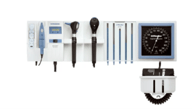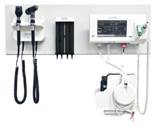Anyone who has spent any time in the hospital knows just how often healthcare professionals come to the bedside to take and record vital signs or conduct a quick diagnostic exam.
Routine trips to the doctor’s office almost always start with the intake healthcare professional recording a patient’s body temperature, blood pressure, and pulse rate. Doctors reach for Ophthalmoscopes and Otoscopes within the first few minutes of an exam.
Quick diagnostic exams and monitoring vital signs are universal and crucial functions in healthcare, regardless of the facility or specialty.
Thoughtfully placed integrated diagnostic wall systems maximize the productivity of these tasks in a landscape challenged by staffing shortages.
This article will explore:
- Configuring Diagnostic Wall Systems
- Assessing Your Medical Environment’s Requirements
- Evaluating the Benefits of Diagnostic Wall Systems
- Comparing Diagnostic Wall Systems
- Diagnostic Wall Systems Buying Guide FAQ
Configuring Diagnostic Wall Systems
Diagnostic wall systems organize all the devices and tools needed to perform a complete diagnostic exam in one location.
Integrated diagnostic wall systems include various configurations of these common instruments:
- Ophthalmoscope (Coaxial or Panoptic)
- Otoscope (macro view)
- Oximeter
- Aneroid or Digital Sphygmomanometer
- Thermometers (oral/ear/temporal)
Look for the following instrument features when evaluating diagnostic wall station instruments:
- Halogen or LED Lamps Illumination
- Auto Off/ Contactless On Handles
- Coiled Cord for handles
- Universal Power Handles
- Antimicrobial surfaces
Creating a Checklist of Essential Diagnostic Wall System Features
In addition to curating a diagnostic wall system with “go to” exam instruments and tools, consider a large, colored, touchscreen monitor to display diagnostic results.
Other features to look for in an integrated wall diagnostic system include:
| Storage Features | Power & Communication Features | Workflow Features |
| Specula Dispenser | EMR Connectivity (wireless, ethernet, or USB) | Pre-Drilled Wall Mounting Board |
| Glove/Tissue Box Holder | USB Power Cable | Mobile Base |
| Wire Storage Basket | Wall Transformer | |
| Storage Container |
Assessing Your Medical Environments
Analyze Workflow
Understanding the workflow of your environment is even more critical today as staffing levels are dwindling in the face of the current shortage of healthcare professionals. Fewer workers make the function of administering diagnostic exams challenging. The right diagnostic exam system can mitigate the challenge and have a positive impact on staff satisfaction and retention.
Within a healthcare facility integrated diagnostic wall systems may be mounted on a wall in a central intake location, mounted on walls in exam rooms or above beds in hospitals.
Easy access to the devices required to capture vital signs or conduct eye and ear assessments contributes to fast and efficient diagnostic examinations.
In some healthcare environments, mobile carts designed to organize vital signs monitoring instruments further improve workflow efficiency.
Identify Required Instruments and Accessories
Begin identifying required diagnostic wall system instruments by determining whether diagnostic exams will be conducted on adult, pediatric or neonatal patients.
Also consider:
Is the environment an acute care hospital wing where patients may require continuous monitoring or a clinic providing routine care that will need spot checks?
Should diagnostic wall stations be standardized across a facility?
Determine Integration and Connectivity Needs
Electronic Medical Records (EMR) and the bigger Electronic Health Record (EHR) landscape have changed how diagnostic information is recorded, stored, and retrieved. Today integrated diagnostic wall systems offer connectivity options for point of care updates to EMR/EHRs.
In the moment digital transfer of data from an EMR ready medical device to the patient chart is instantaneous and reduces, if not eliminates transcription errors.
Check with the healthcare facility IT and/or Biomedical department to determine if wireless, ethernet, or USB connectivity is in place for medical equipment.
Review the manufacturers specifications to confirm that the diagnostic wall system under consideration is EMR/EHR ready. CME experts can also help identify diagnostic wall systems with connectivity.
Evaluate the Benefits of Diagnostic Wall Systems
Like any medical equipment, Diagnostic Wall Systems have start-up and maintenance costs associated with them. The cost of an asset is often evaluated solely on the quantifiable purchase price and cost of maintenance.
However, when considering cost there is value in looking at qualifiable benefits that offset the direct quantifiable cost. Benefits may be indirectly associated with the cost of medical equipment and instruments but can be directly related to the cost of staffing shortages.
The benefits of custom configuring diagnostic examination instruments and vital signs monitors into a diagnostic wall system are numerous.
For the staff, the benefits include:
- All tools in one easy-to-reach location.
- Properly sized instruments.
- No wasted time looking for instruments.
- Instruments are always ready for use.
- Fast and efficient diagnostic examinations.
- Instant recording of vitals to patient charts from point of care
- Accurate, easy-to-share and save vital signs information.
- Organized supplies at the point of need.
- No tangled cords.
- Minimal instrument breakage.
Benefits to the patient include:
- Properly sized diagnostic devices offer more comfort.
- Productive diagnostic examinations.
- Accurately recorded and sharable health information.
Staff and Patient satisfaction are hot topics in today’s healthcare landscape. Integrated diagnostic wall systems configured with carefully selected EMR/EHR ready instruments and useful accessories address both staff and patient satisfaction with one solution.
Compare Diagnostic Wall Systems
CME Corp. offers a variety of standard diagnostic wall systems. We will also work with manufacturers to help you configure a wall system that exactly meets the unique needs of your hospital, clinic, private practice, or the departments within a single facility.
Here is a small sample of the diagnostic wall systems and integrated wall systems available through CME.
Explore the CME Corp. online shop for the complete selection.
| Manufacturer | Features | |
|
|
ADC | Wall transformer w/ Otoscope, Ophthalmoscope, and clock Aneroid |

|
Midmark | Wall Transformer w/ Otoscope and Ophthalmoscope |

|
Riester | Integrated Wall System with Otoscope, Ophthalmoscope, Specula Dispenser, Aneroid Blood Pressure Device, and Infrared Thermometer |

|
Welch Allyn | Integrated Wall System with mounting options for vital signs monitors, ophthalmoscope, otoscope, and specula dispenser |
In summary, integrated diagnostic wall systems are a staple in the healthcare environment. They provide organized, easy access to the diagnostic and vital signs monitoring devices used most often by healthcare professionals.
Evaluating the specific needs and workflow of a healthcare facility is critical to configuring a diagnostic wall station that will be accurate and efficient.
Finally, purchasing integrated diagnostic wall stations that are EMR/EHR ready positions the healthcare organization for the future.
CME experts are ready to work with your equipment planners and purchasing departments to configure wall systems for the most benefit to staff and patients, at the best price.
Direct-to-Site and Biomedical Technicians ensure that the equipment will be delivered, installed, ready to use, and maintained for uninterrupted patient care.
CHAT with us to learn more.
Diagnostic Wall Systems Buying Guide FAQ
What is an example of diagnostic equipment?
Diagnostic medical equipment monitors blood pressure, pulse, body temperature, and pulse. Ear and eye exams are performed with diagnostic medical equipment. Common diagnostic devices include:
- blood pressure cuffs,
- thermometers,
- pulse oximeters,
- ophthalmoscopes, and
- otoscopes
What are the 4 types of diagnostic testing?
Diagnostic testing includes:
Laboratory tests – blood or urine tests,
Imaging test – X-Ray, CT scan, and Mammography,
Endoscopy – colonoscopy and bronchoscopy, and
Biopsy.
What are the 7 commonly performed diagnostic tests?
Commonly performed diagnostic tests include routine blood pressure, body temperature, and pulse. 7 other common diagnostic tests include:
- Pathology,
- Mammograms,
- X-ray
- CT scan
- PET scans
- Ultrasound,
- Blood or Urine tests
About CME: CME Corp is the nation’s premier source for healthcare equipment, turnkey logistics, and biomedical services, representing 2 million+ products from more than 2,000 manufacturers. With two corporate offices and 35+ service centers, our mission is to help healthcare facilities nationwide reduce the cost of the equipment they purchase, make their equipment specification, delivery, installation, and maintenance processes more efficient, and help them seamlessly launch, renovate and expand on schedule.




